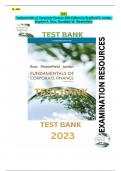TB - 2023
2023
Fundamentals of Corporate Finance 10th Edition by Bradford D. Jordan,
Stephen A. Ross, Randolph W. Westerfield.
,TB - 2023
Test bank for Fundamentals of Corporate Finance 10th
Edition by Bradford D. Jordan, Stephen A. Ross,
Randolph W. Westerfield.
ISBN-10 0323661343
ISBN-13 978-0323661348
Test bank for Fundamentals of Corporate Finance 10th Edition by Bradford D. Jordan,
Stephen A. Ross, Randolph W. Westerfield.
ISBN-10 0323661343
ISBN-13 978-0323661348
THIS IS NOT THE ORIGINAL BOOK. You are purchasing the official test bank in
electronic format available for instant download.
Professors often use the test bank as a template for creating exams, so you have a high
likelihood of encountering the exact questions on your tests!
The files come in PDF, Excel, or zipped formats and are easily accessible on both PCs and
Macs.
Delivery is instant—you can download the files immediately after completing your
payment.
If you have any questions, feel free to reach out to us. We pride ourselves on fast
responses, typically within 30 minutes and always within 6 hours.
We've been in your shoes and understand the challenges you face as students. However, with the Official Test
Bank, you can:
Predict the types of questions that will appear on your exam.
Learn the correct answers to those questions.
Alleviate the hassle and stress of student life.
Enhance your studying and achieve better grades.
Get ready for examination questions.
Save time and gain a deeper understanding of the material.
,TB - 2023
TABLE OF CONTENTS
CHAPTER 1 INTRODUCTION TO CORPORATE FINANCE
CHAPTER 2 FINANCIAL STATEMENTS, TAXES, AND CASH FLOW
CHAPTER 3 WORKING WITH FINANCIAL STATEMENTS
CHAPTER 4 LONG-TERM FINANCIAL PLANNING AND GROWTH
CHAPTER 5 INTRODUCTION TO VALUATION: THE TIME VALUE OF MONEY
CHAPTER 6 DISCOUNTED CASH FLOW VALUATION
CHAPTER 7 INTEREST RATES AND BOND VALUATION
CHAPTER 8 STOCK VALUATION
CHAPTER 9 NET PRESENT VALUE AND OTHER INVESTMENT CRITERIA
CHAPTER 10 MAKING CAPITAL INVESTMENT DECISIONS
CHAPTER 11 PROJECT ANALYSIS AND EVALUATION
CHAPTER 12 SOME LESSONS FROM CAPITAL MARKET HISTORY
CHAPTER 13 RISK, RETURN, AND THE SECURITY MARKET LINE
CHAPTER 14 COST OF CAPITAL
CHAPTER 15 RAISING CAPITAL
CHAPTER 16 FINANCIAL LEVERAGE AND CAPITAL STRUCTURE POLICY
CHAPTER 17 DIVIDENDS AND DIVIDEND POLICY
CHAPTER 18 SHORT-TERM FINANCE AND PLANNING
CHAPTER 19 CASH AND LIQUIDITY MANAGEMENT
CHAPTER 20 CREDIT AND INVENTORY MANAGEMENT
CHAPTER 21 INTERNATIONAL CORPORATE FINANCE
CHAPTER 22 BEHAVIORAL FINANCE: IMPLICATIONS FOR FINANCIAL MANAGEMENT
CHAPTER 23 ENTERPRISE RISK MANAGEMENT
CHAPTER 24 OPTIONS AND CORPORATE FINANCE
CHAPTER 25 OPTION VALUATION
CHAPTER 26 MERGERS AND ACQUISITIONS
CHAPTER 27 LEASING
, CHAPTER 1
INTRODUCTION TO CORPORATE
FINANCE
Answers to Concepts Review and Critical Thinking Questions
1. Capital budgeting (deciding whether to expand a manufacturing plant), capital structure (deciding
whether to issue new equity and use the proceeds to retire outstanding debt), and working capital
management (modifying the firm’s credit collection policy with its customers).
2. Disadvantages: unlimited liability, limited life, difficulty in transferring ownership, difficulty in
raising capital funds. Some advantages: simpler, less regulation, the owners are also the managers,
sometimes personal tax rates are better than corporate tax rates.
3. The primary disadvantage of the corporate form is the double taxation to shareholders of distributed
earnings and dividends. Some advantages include: limited liability, ease of transferability, ability to
raise capital, and unlimited life.
4. In response to Sarbanes-Oxley, small firms have elected to go dark because of the costs of
compliance. The costs to comply with Sarbox can be several million dollars, which can be a large
percentage of a small firm’s profits. A major cost of going dark is less access to capital. Since the
firm is no longer publicly traded, it can no longer raise money in the public market. Although the
company will still have access to bank loans and the private equity market, the costs associated with
raising funds in these markets are usually higher than the costs of raising funds in the public market.
5. The treasurer’s office and the controller’s office are the two primary organizational groups that
report directly to the chief financial officer. The controller’s office handles cost and financial
accounting, tax management, and management information systems, while the treasurer’s office is
responsible for cash and credit management, capital budgeting, and financial planning. Therefore,
the study of corporate finance is concentrated within the treasury group’s functions.
6. To maximize the current market value (share price) of the equity of the firm (whether it’s publicly
traded or not).
7. In the corporate form of ownership, the shareholders are the owners of the firm. The shareholders
elect the directors of the corporation, who in turn appoint the firm’s management. This separation of
ownership from control in the corporate form of organization is what causes agency problems to
exist. Management may act in its own or someone else’s best interests, rather than those of the
shareholders. If such events occur, they may contradict the goal of maximizing the share price of the
equity of the firm.
8. A primary market transaction.




